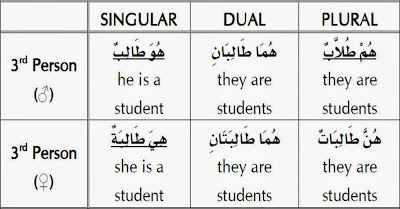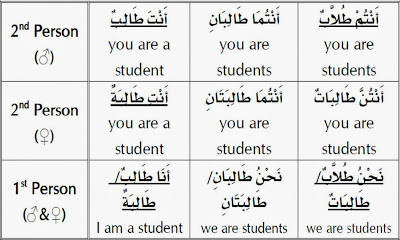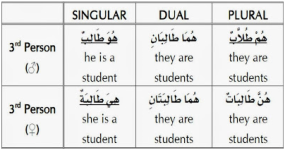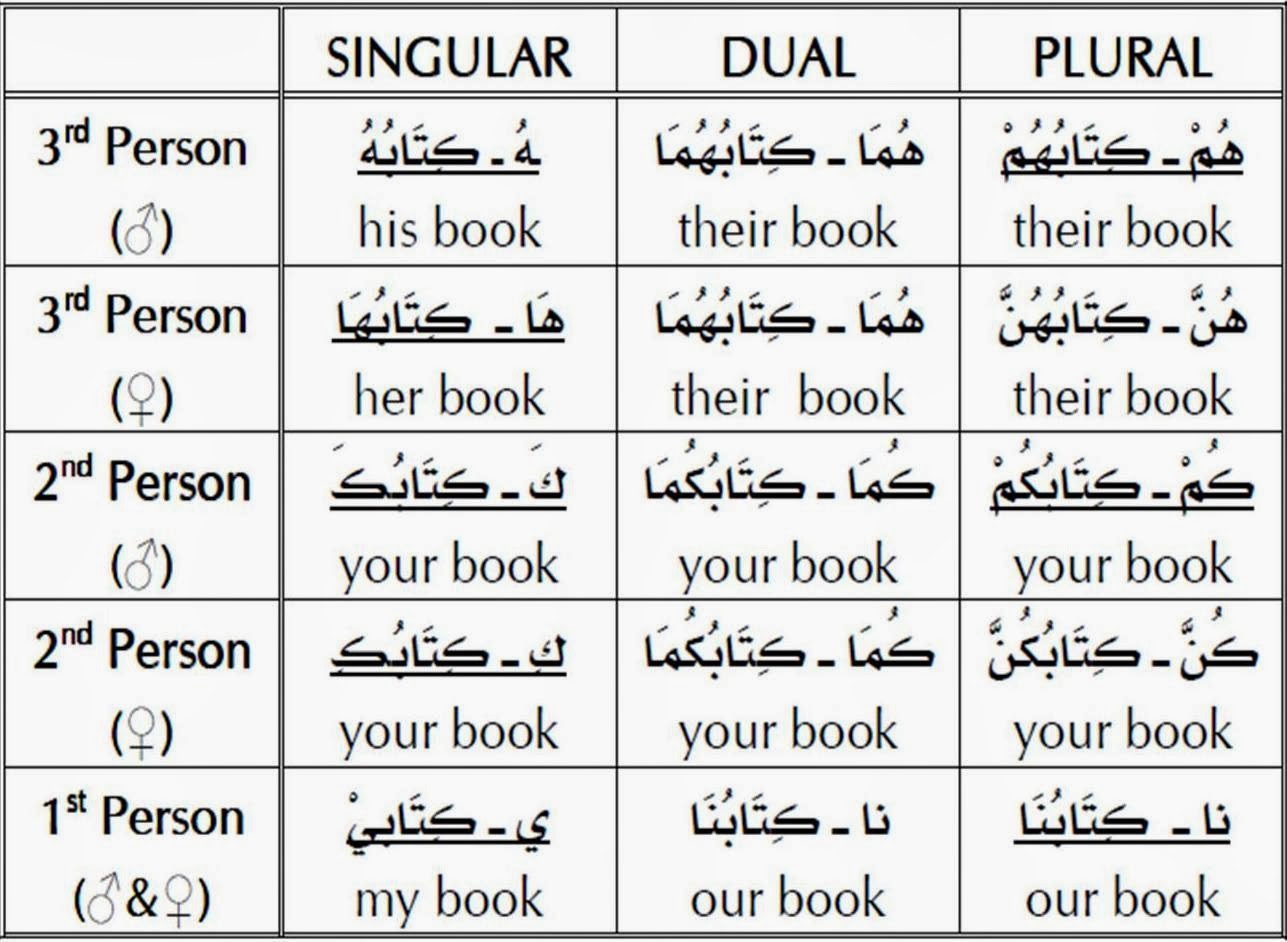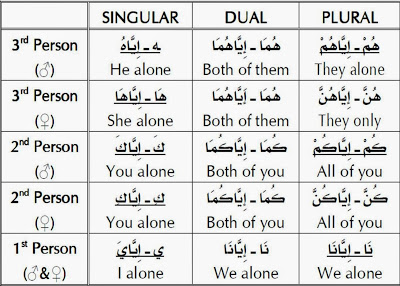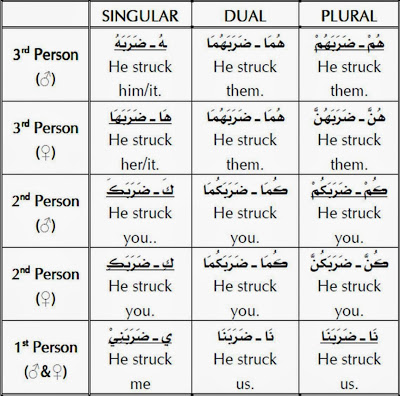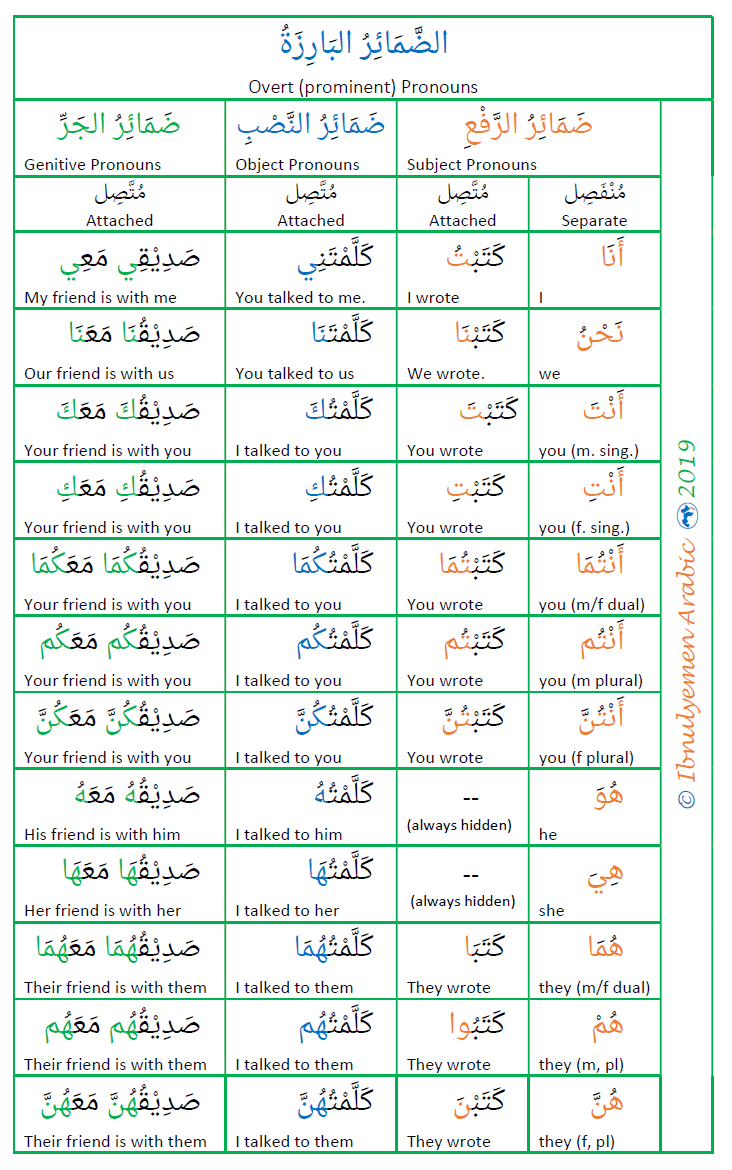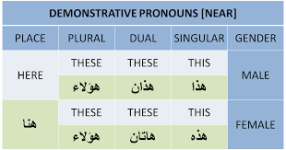You are using an out of date browser. It may not display this or other websites correctly.
You should upgrade or use an alternative browser.
You should upgrade or use an alternative browser.
Arabic Grammar Simplified
- Thread starter Abrars
- Start date
- Replies 38
- Views 40K
British Wholesales - Certified Wholesale Linen & Towels | Halal Food Gastronomy | PHP 8.4 patch for vBulletin 4.2.5
09 Persons of Pronouns :
Very similar to Persons of Pronouns of English Grammar , Arabic grammar has also 3 Persons :
a- First Person (Mutakallim/المتكلم)
أَنَا (Ana) – I (sing.Male/Female)
نَحْنُ (Nahnu) – We (pl.Male/Female)
b- Second Person ( Mukhataab/المخاطب)
أَنْتَ (Anta) – You (sing.Male)
أَنْتِ(Anti) – You (sing.Female)
أَنْتُما (Antuma) You (dual. Male/Female)
أَنْتُم(Antum) – You (pl. Male)
أَنْتُنَّ(Antunna) – You (pl.Female)
c- Third Person (Ghaaib/الغائب)
هُوَ (Huwa)-He (sing.Male)
هِيَ(Hiya)-She (sing.Female)
هُمَا (Huma) – They (dual. Male/Female)
هُم(Hum) – They (pl. Male)
هُنَّ (Hunna) – They (pl. Female)
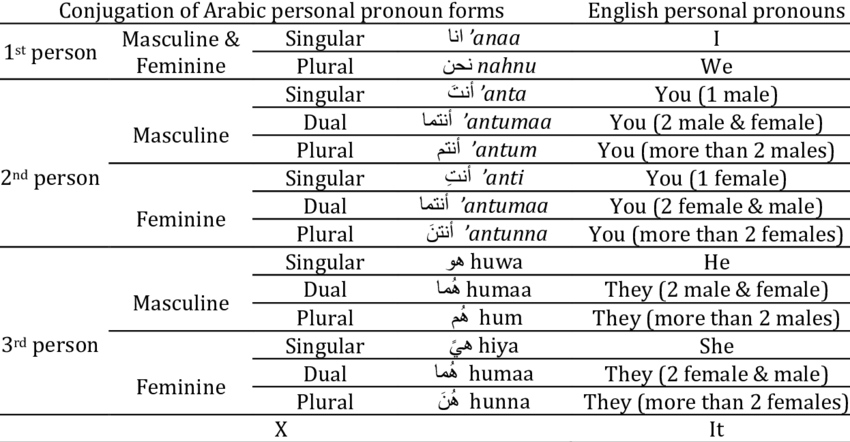
Very similar to Persons of Pronouns of English Grammar , Arabic grammar has also 3 Persons :
a- First Person (Mutakallim/المتكلم)
أَنَا (Ana) – I (sing.Male/Female)
نَحْنُ (Nahnu) – We (pl.Male/Female)
b- Second Person ( Mukhataab/المخاطب)
أَنْتَ (Anta) – You (sing.Male)
أَنْتِ(Anti) – You (sing.Female)
أَنْتُما (Antuma) You (dual. Male/Female)
أَنْتُم(Antum) – You (pl. Male)
أَنْتُنَّ(Antunna) – You (pl.Female)
c- Third Person (Ghaaib/الغائب)
هُوَ (Huwa)-He (sing.Male)
هِيَ(Hiya)-She (sing.Female)
هُمَا (Huma) – They (dual. Male/Female)
هُم(Hum) – They (pl. Male)
هُنَّ (Hunna) – They (pl. Female)

MazharShafiq
IB Expert
- Messages
- 2,301
- Reaction score
- 16
- Gender
- Male
- Religion
- Islam
This is beneficial for learning
10- Idafa Construction (Idafa/الإضافة):
It is a very simple but important construction of a Arabic sentence where 2 nouns sitting together showing a relation of possession ( The book of John/Joh’n book – for example) . Let us see the following example :
كِتَابُ مُحَمَّدٍ ( Kitabu Muammadin) – Muhammad’s book.
Rule:
01- The first noun which is possessed called Mudaf (مُضَافٌ ) , Here the book (كِتَابُ) is the Mudaf .
02- The second noun who is a possessor is called Mudaf Ilayhi (مُضَافٌ إِلَيْهِ ). Here Muhammad (مُحَمَّدٍ) is a Mudaf Ilayhi .
03- Mudaf is always without Tanwin and without ال
04- Mudaf Ilayhi is always Majrur/Genitive , meaning the end letter always take Kasra (Muhammadin ) . If it is not a Proper Noun it must start with ال and also take kasra at the end (ex. قَلَمُ المُدَرِّسِ = Teacher’s pen) . .
Few more examples :
[TABLE="width: 670"]
[TR]
[TD] 1. A university professor (a professor of a university)
[/TD]
[TD]١. أستاذُ جامعةٍ
[/TD]
[/TR]
[TR]
[TD] 2. The office director (the director of the office)
[/TD]
[TD]٢. مدير المكتبِ
[/TD]
[/TR]
[TR]
[TD] 3. A teacher’s house (a house of a teacher)
[/TD]
[TD]٣. بيتُ مدرسٍ
[/TD]
[/TR]
[TR]
[TD] 4. The teacher’s house (the house of the teacher)
[/TD]
[TD]٤. بيتُ المدرسِ
[/TD]
[/TR]
[TR]
[TD] 5. An office director’s car (a car of a director of an office)
[/TD]
[TD]٥. سيارةُ مديرِ مكتبٍ
[/TD]
[/TR]
[TR]
[TD] 6. The office director’s car (the car of the director of the office).
[/TD]
[TD]٦. سيارةُ مديرِ المكتبِ
[/TD]
[/TR]
[/TABLE]

It is a very simple but important construction of a Arabic sentence where 2 nouns sitting together showing a relation of possession ( The book of John/Joh’n book – for example) . Let us see the following example :
كِتَابُ مُحَمَّدٍ ( Kitabu Muammadin) – Muhammad’s book.
Rule:
01- The first noun which is possessed called Mudaf (مُضَافٌ ) , Here the book (كِتَابُ) is the Mudaf .
02- The second noun who is a possessor is called Mudaf Ilayhi (مُضَافٌ إِلَيْهِ ). Here Muhammad (مُحَمَّدٍ) is a Mudaf Ilayhi .
03- Mudaf is always without Tanwin and without ال
04- Mudaf Ilayhi is always Majrur/Genitive , meaning the end letter always take Kasra (Muhammadin ) . If it is not a Proper Noun it must start with ال and also take kasra at the end (ex. قَلَمُ المُدَرِّسِ = Teacher’s pen) . .
Few more examples :
[TABLE="width: 670"]
[TR]
[TD] 1. A university professor (a professor of a university)
[/TD]
[TD]١. أستاذُ جامعةٍ
[/TD]
[/TR]
[TR]
[TD] 2. The office director (the director of the office)
[/TD]
[TD]٢. مدير المكتبِ
[/TD]
[/TR]
[TR]
[TD] 3. A teacher’s house (a house of a teacher)
[/TD]
[TD]٣. بيتُ مدرسٍ
[/TD]
[/TR]
[TR]
[TD] 4. The teacher’s house (the house of the teacher)
[/TD]
[TD]٤. بيتُ المدرسِ
[/TD]
[/TR]
[TR]
[TD] 5. An office director’s car (a car of a director of an office)
[/TD]
[TD]٥. سيارةُ مديرِ مكتبٍ
[/TD]
[/TR]
[TR]
[TD] 6. The office director’s car (the car of the director of the office).
[/TD]
[TD]٦. سيارةُ مديرِ المكتبِ
[/TD]
[/TR]
[/TABLE]

10- Idafa Construction (Idafa/الإضافة):
It is a very simple but important construction of a Arabic sentence where 2 nouns sitting together showing a relation of possession ( The book of John/Joh’n book – for example) . Let us see the following example :
كِتَابُ مُحَمَّدٍ ( Kitabu Muammadin) – Muhammad’s book.
Rule:
01- The first noun which is possessed called Mudaf (مُضَافٌ ) , Here the book (كِتَابُ) is the Mudaf .
02- The second noun who is a possessor is called Mudaf Ilayhi (مُضَافٌ إِلَيْهِ ). Here Muhammad (مُحَمَّدٍ) is a Mudaf Ilayhi .
03- Mudaf is always without Tanwin and without ال
04- Mudaf Ilayhi is always Majrur/Genitive , meaning the end letter always take Kasra (Muhammadin ) . If it is not a Proper Noun it must start with ال and also take kasra at the end (ex. قَلَمُ المُدَرِّسِ = Teacher’s pen) . .
Few more examples :
[TABLE="width: 670"]
[TR]
[TD] 1. A university professor (a professor of a university)
[/TD]
[TD]١. أستاذُ جامعةٍ
[/TD]
[/TR]
[TR]
[TD] 2. The office director (the director of the office)
[/TD]
[TD]٢. مدير المكتبِ
[/TD]
[/TR]
[TR]
[TD] 3. A teacher’s house (a house of a teacher)
[/TD]
[TD]٣. بيتُ مدرسٍ
[/TD]
[/TR]
[TR]
[TD] 4. The teacher’s house (the house of the teacher)
[/TD]
[TD]٤. بيتُ المدرسِ
[/TD]
[/TR]
[TR]
[TD] 5. An office director’s car (a car of a director of an office)
[/TD]
[TD]٥. سيارةُ مديرِ مكتبٍ
[/TD]
[/TR]
[TR]
[TD] 6. The office director’s car (the car of the director of the office).
[/TD]
[TD]٦. سيارةُ مديرِ المكتبِ[/TD]
[/TR]
[/TABLE]
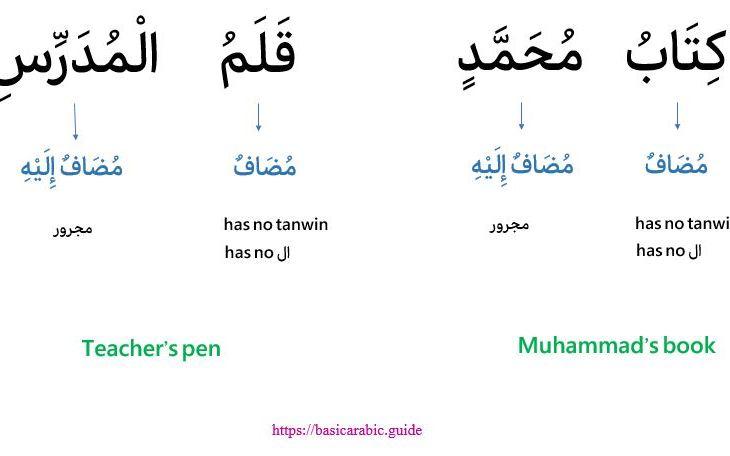
11 Arabic Comparative and Superlative Degree / Elative Degree (Tafdeel/التفضل):
[h=3]In Arabic Superlative and Comparative constructions both follow the same spelling/form أفعل ( Prefixed Alif with the original word) . For example :[/h][h=3]سهل – أسهل[/h][h=3]صعب – أصعب[/h][h=3]جميل – أجمل[/h][h=3]سعيد – أسعد[/h][h=3]كبير – أكبر[/h]
Differentiating between comparative and superlative degree:
- For the comparative degree we use the noun on the pattern أَفْــعَــلُ followed by مِــنْ.
Mohammed is better than Hamid.
مُحَمَّدٌ أَحْــسَــنُ مِــنْ حَامــِدٍ
- For the superlative degree as well, we use the same noun on the pattern أَفْــعَــلُ followed by a noun in مَجْرُور case ( Kasra sign to be observed )
Ibrahim is the best student in the school.
إِبْــراهِيــمُ أَحْــسَــنُ طَــالِــبٍ فِي الــمَــدْرَسَــةِ
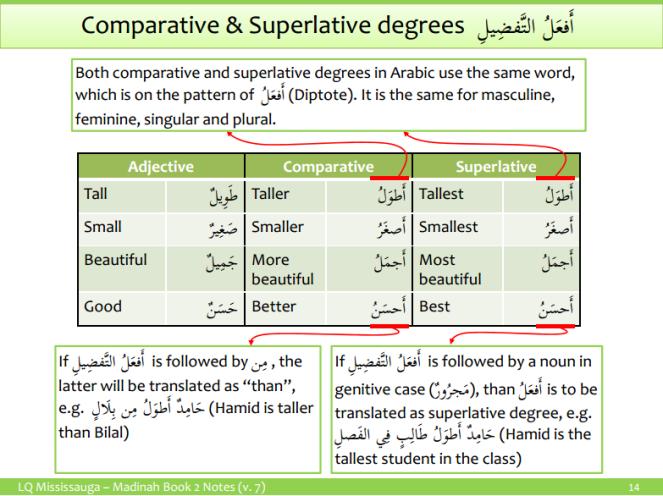
[h=3]In Arabic Superlative and Comparative constructions both follow the same spelling/form أفعل ( Prefixed Alif with the original word) . For example :[/h][h=3]سهل – أسهل[/h][h=3]صعب – أصعب[/h][h=3]جميل – أجمل[/h][h=3]سعيد – أسعد[/h][h=3]كبير – أكبر[/h]
Differentiating between comparative and superlative degree:
- For the comparative degree we use the noun on the pattern أَفْــعَــلُ followed by مِــنْ.
Mohammed is better than Hamid.
مُحَمَّدٌ أَحْــسَــنُ مِــنْ حَامــِدٍ
- For the superlative degree as well, we use the same noun on the pattern أَفْــعَــلُ followed by a noun in مَجْرُور case ( Kasra sign to be observed )
Ibrahim is the best student in the school.
إِبْــراهِيــمُ أَحْــسَــنُ طَــالِــبٍ فِي الــمَــدْرَسَــةِ

12 Verbal Noun (Masdar/مَصْدِرٌ ):
In Arabic verbal noun is a noun which is derived from other words and other words can be derived from it . It has no tense and it has no subject . For example:
‘Murder’ (قَتْلٌ) is a verbal noun because:
-It has no tense and it has no subject
-It is derived from ‘To Murder’ (قَتَلَ)
- It is going to derive to other words like ‘Murderer’ ( قَاتِلٌ) and ‘Murdered’ ( مَقْتُوْلٌ).

In Arabic verbal noun is a noun which is derived from other words and other words can be derived from it . It has no tense and it has no subject . For example:
‘Murder’ (قَتْلٌ) is a verbal noun because:
-It has no tense and it has no subject
-It is derived from ‘To Murder’ (قَتَلَ)
- It is going to derive to other words like ‘Murderer’ ( قَاتِلٌ) and ‘Murdered’ ( مَقْتُوْلٌ).

13 Rigid Noun (Jamid/جَامِدْ):
Opposite to the Masdar as discussed in section 12 , Jamid are nouns which are not derived from any words nor any words would derive from it. It inflexible and frozen , always . The defective noun is either person اسم ذات or abstract اسم معنى
Examples: Elephant = فِيْلٌ
Horse = فَرَسٌ
- - - Updated - - -
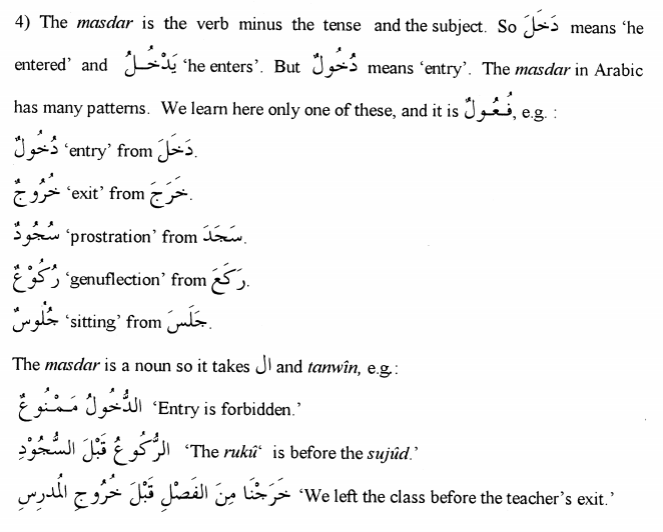
Opposite to the Masdar as discussed in section 12 , Jamid are nouns which are not derived from any words nor any words would derive from it. It inflexible and frozen , always . The defective noun is either person اسم ذات or abstract اسم معنى
Examples: Elephant = فِيْلٌ
Horse = فَرَسٌ
- - - Updated - - -
12 Verbal Noun (Masdar/مَصْدِرٌ ):
In Arabic verbal noun is a noun which is derived from other words and other words can be derived from it . It has no tense and it has no subject . For example:
‘Murder’ (قَتْلٌ) is a verbal noun because:
-It has no tense and it has no subject
-It is derived from ‘To Murder’ (قَتَلَ)
- It is going to derive to other words like ‘Murderer’ ( قَاتِلٌ) and ‘Murdered’ ( مَقْتُوْلٌ).


14 Noun of Instrument (Ism Alah'/ اِسْم آله):
As the name suggests, this noun is acting as the instrument to execute an action. Simply in English ‘to open’ is an action and for this you need an instrument called ‘key’ . In Arabic it is more systematic and logical .
Examples:
Miftah/مِفْتَاح (Key) from Fatha/فَتَحَ (Open)
Miqas/مِقَص (Scissor) from Qassa/قَصَّ ( Cut)
These nouns use mainly three forms :
مِفْعَالٌ (Mif-alun)
مِفْعَلَةٌ (Mif-altun)
مِفْعَلٌ (Mif-al)
As the name suggests, this noun is acting as the instrument to execute an action. Simply in English ‘to open’ is an action and for this you need an instrument called ‘key’ . In Arabic it is more systematic and logical .
Examples:
Miftah/مِفْتَاح (Key) from Fatha/فَتَحَ (Open)
Miqas/مِقَص (Scissor) from Qassa/قَصَّ ( Cut)
These nouns use mainly three forms :
مِفْعَالٌ (Mif-alun)
مِفْعَلَةٌ (Mif-altun)
مِفْعَلٌ (Mif-al)
15 Subject Noun/Doer Noun/Active Participles (Ism Faail / اسم فاعل):
These nouns are the nouns which are subjects or doers of an action in the sentence . As in English (eg. Killer = Kill+er , Doer= Do+er) , Arabic Subject Nouns are also formed by adding ‘alif’ between the 1[SUP]st[/SUP] and 2[SUP]nd[/SUP] letter . Examples:
- كتب – كاتب ( Kataba/to write – Kaatib/Writer)
- حمل – حامل (Hamala/to bear- Haamil/bearer)
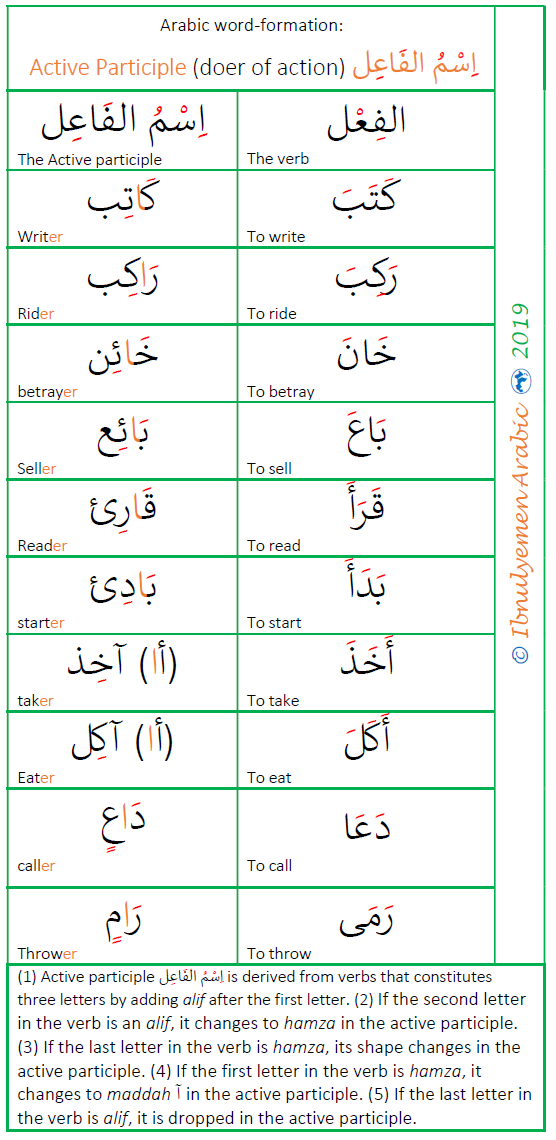
These nouns are the nouns which are subjects or doers of an action in the sentence . As in English (eg. Killer = Kill+er , Doer= Do+er) , Arabic Subject Nouns are also formed by adding ‘alif’ between the 1[SUP]st[/SUP] and 2[SUP]nd[/SUP] letter . Examples:
- كتب – كاتب ( Kataba/to write – Kaatib/Writer)
- حمل – حامل (Hamala/to bear- Haamil/bearer)

16 Passive Participle / Object Participles (Ism Mafool/ اسم المفعول) :
It is a specific noun using specific form to denote the object of a subject in the sentence. As the name offers, ‘Mafool’ / المفعول , it is formed by adding ‘mim’ in beginning and ‘waw’ before the last letter of the original word . Examples:
- Daraba/ ضرب ( To hit) – Madroob / مضروب (The one who was hit)
- Nasara/ نصر ( To help) – Mansoor / منصور ( The one who was helped)
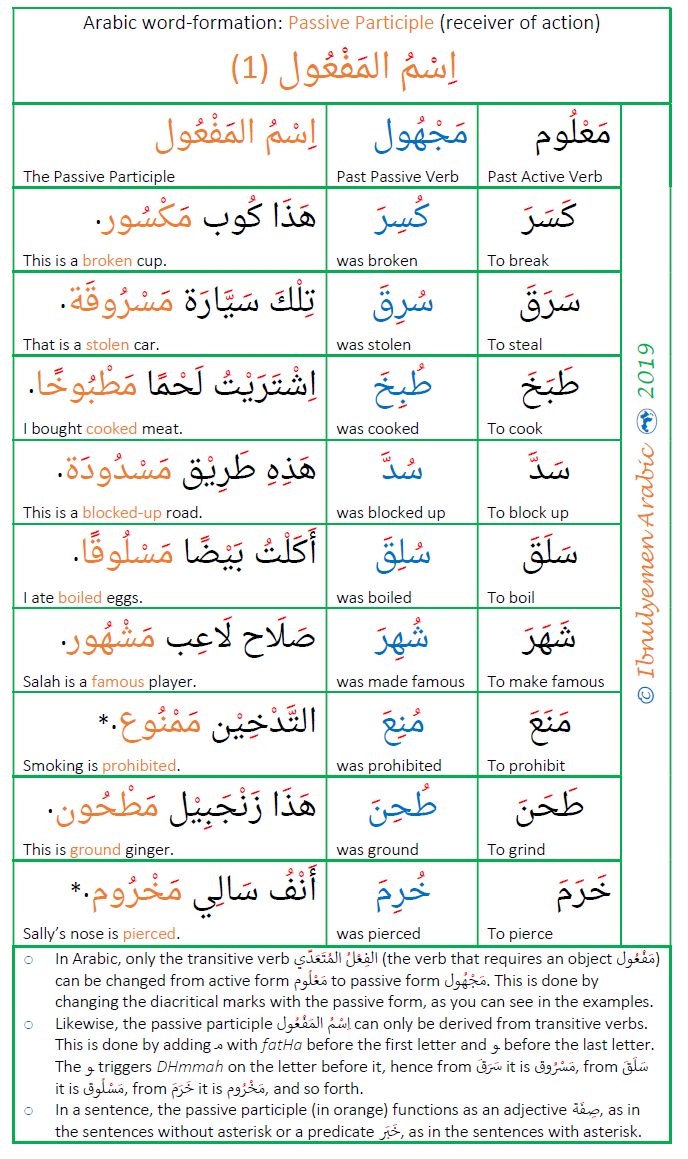
It is a specific noun using specific form to denote the object of a subject in the sentence. As the name offers, ‘Mafool’ / المفعول , it is formed by adding ‘mim’ in beginning and ‘waw’ before the last letter of the original word . Examples:
- Daraba/ ضرب ( To hit) – Madroob / مضروب (The one who was hit)
- Nasara/ نصر ( To help) – Mansoor / منصور ( The one who was helped)

17 Noun of attributes (Ism Sifah/ اسم سفة) :
It is also called Ism Musabbaha (المشبَّهة) . It is an adjective same like Ism Fa’il as discussed earlier section (15) , but the difference is :
01- It’s common form is فعيل unlike Ism Faail whose common form is فاعل
02- Ism Faail denotes a quality which is not permanent and inherent while Islm Musabbaha denotes a permanent and inherent quality. For example , عالم ( Aalim/Knowing ) could be a quality of a person but when it takes the form Ism Sifah , the spelling عليم (Aliim/All-Knowing) , most of the cases in Qur’an it is only reserved for the Quality of ALLAH swt .

It is also called Ism Musabbaha (المشبَّهة) . It is an adjective same like Ism Fa’il as discussed earlier section (15) , but the difference is :
01- It’s common form is فعيل unlike Ism Faail whose common form is فاعل
02- Ism Faail denotes a quality which is not permanent and inherent while Islm Musabbaha denotes a permanent and inherent quality. For example , عالم ( Aalim/Knowing ) could be a quality of a person but when it takes the form Ism Sifah , the spelling عليم (Aliim/All-Knowing) , most of the cases in Qur’an it is only reserved for the Quality of ALLAH swt .

18 Hyperbole Noun ( Ism Mubaalagah/ اِسم مُبَالَغَةْ):
While we study Ism Faail and Ism Sifah , we must also study the Ism Mubaalagah as they are very close buy yet different subtly , especially when we read the attributes of persons and ALLAH swt in Qur’an . So,
01- These Ism are not permanent and inherent like Ism Sifah rather temporary and humanly like Ism Faail .
02- The difference between Ism Faail and Ism Mubaalagah is that Ism Faail denotes a simple quality of a person while Ism Mubaalagah denotes a exaggerate or hyperbole quality of a person . For example , كاذب/ Kadhib is simply a liar while in Ism Mubaalagah it spells كَذَّابْ/Kadhdhab means an incessant liar . Thus عالم/Alim is just a knowing person but عَلَّامَ/Allama is an intensively knowing person .
03- It takes common forms are :
فَعُول
فَعَّال
فَعلَان

While we study Ism Faail and Ism Sifah , we must also study the Ism Mubaalagah as they are very close buy yet different subtly , especially when we read the attributes of persons and ALLAH swt in Qur’an . So,
01- These Ism are not permanent and inherent like Ism Sifah rather temporary and humanly like Ism Faail .
02- The difference between Ism Faail and Ism Mubaalagah is that Ism Faail denotes a simple quality of a person while Ism Mubaalagah denotes a exaggerate or hyperbole quality of a person . For example , كاذب/ Kadhib is simply a liar while in Ism Mubaalagah it spells كَذَّابْ/Kadhdhab means an incessant liar . Thus عالم/Alim is just a knowing person but عَلَّامَ/Allama is an intensively knowing person .
03- It takes common forms are :
فَعُول
فَعَّال
فَعلَان

19 Demonstrative Pronouns (Ism Isharah/اسم الاشاره):
Demonstrative Pronouns are used to indicate noun/pronouns in Arabic using this , that , those etc. . In Arabic sentence it sits before the noun and differs as per the gender of the noun . Similar to English , it also changes as the object is near or far .
Examples :
1.That is a ship - تِلْكَ سَفِينَةٌ
2. This is a man - هَذَا رَزُلٌ
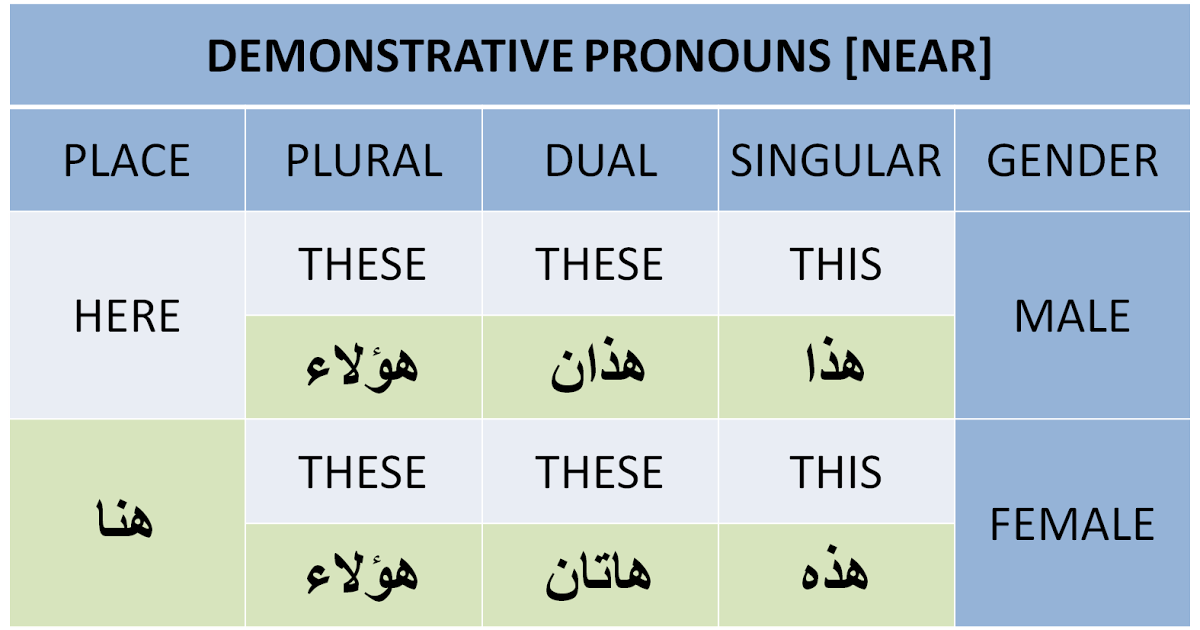
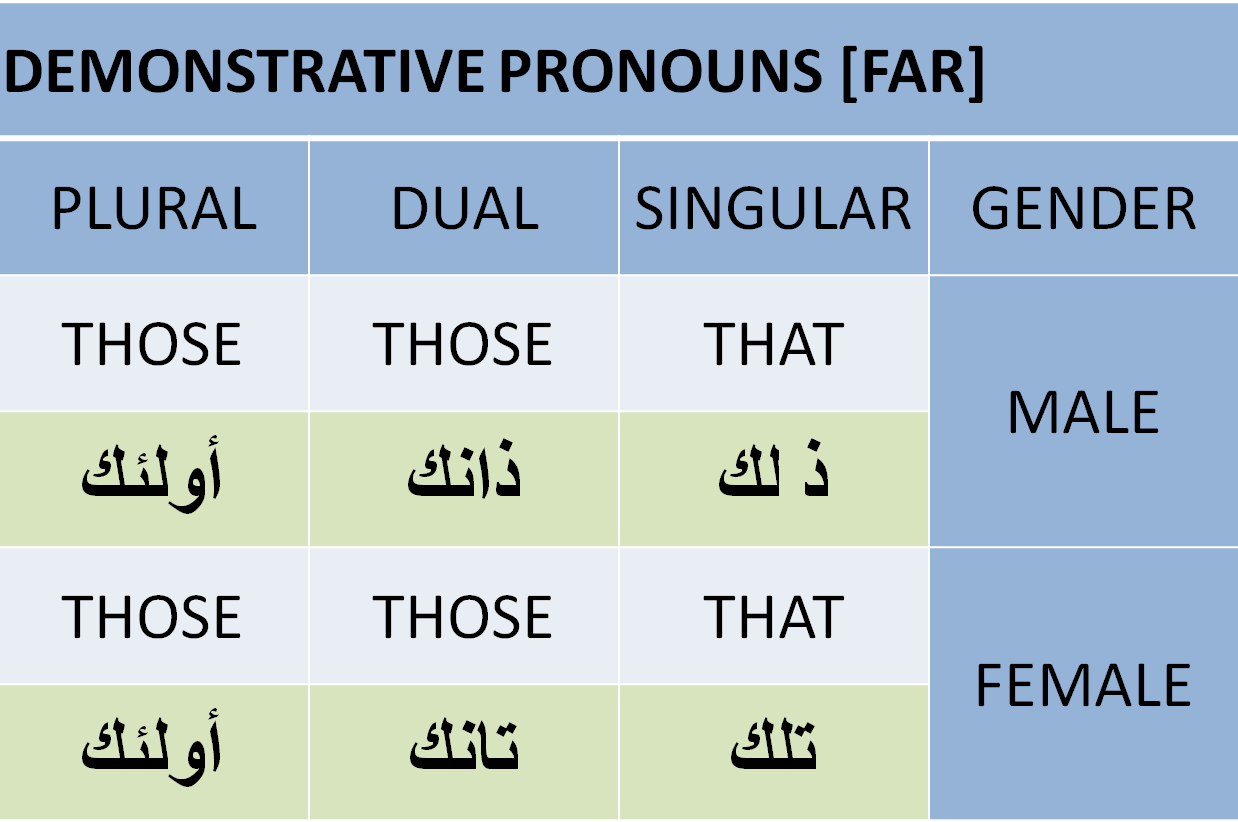
Demonstrative Pronouns are used to indicate noun/pronouns in Arabic using this , that , those etc. . In Arabic sentence it sits before the noun and differs as per the gender of the noun . Similar to English , it also changes as the object is near or far .
Examples :
1.That is a ship - تِلْكَ سَفِينَةٌ
2. This is a man - هَذَا رَزُلٌ


Attachments
20 Relative Pronouns (Ism Ma'suul/الأسماء الموصولة):
In the English Language the main relative pronouns are: who, whom, whose, which and that. Their main function is to link a relative clause to a preceding noun. Similarly, in Arabic the relative pronoun – الإسْم المَوْصُوْل is a Pronoun that something is connected to. For example:
: The book that I read - الكتاب الذي قرأته
:This is the school I go to - هذه هي المدرسة التي أذهب إليها
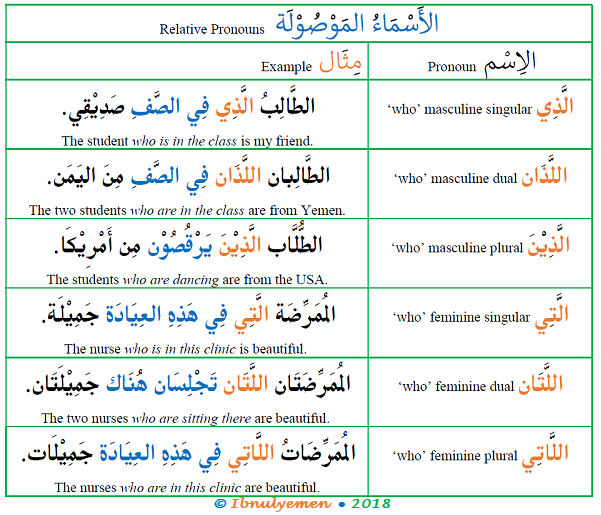
In the English Language the main relative pronouns are: who, whom, whose, which and that. Their main function is to link a relative clause to a preceding noun. Similarly, in Arabic the relative pronoun – الإسْم المَوْصُوْل is a Pronoun that something is connected to. For example:
: The book that I read - الكتاب الذي قرأته
:This is the school I go to - هذه هي المدرسة التي أذهب إليها

Similar Threads
Add to Homescreen
How to install the app on iOS
Follow along with the video below to see how to install our site as a web app on your home screen.
Note: This feature may not be available in some browsers.

